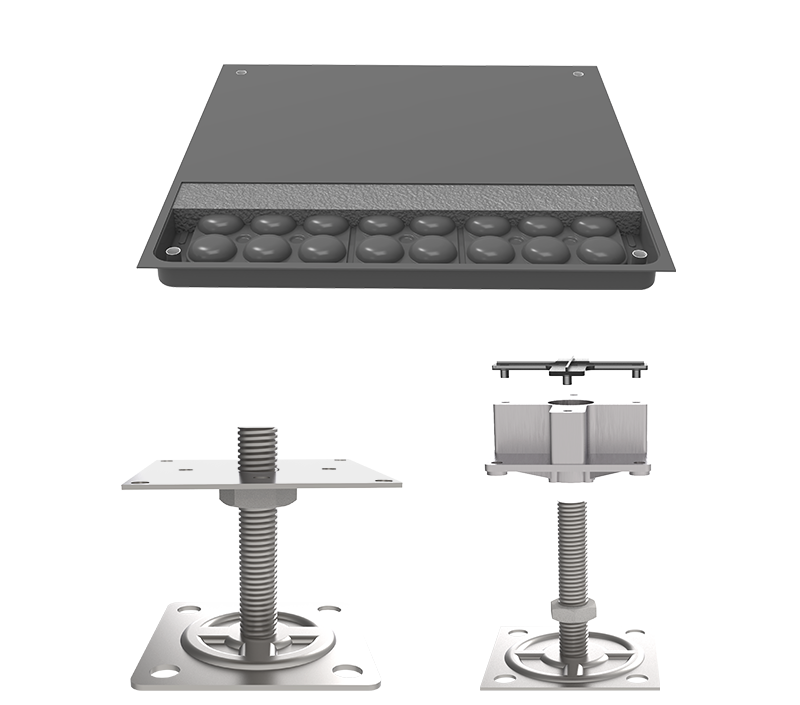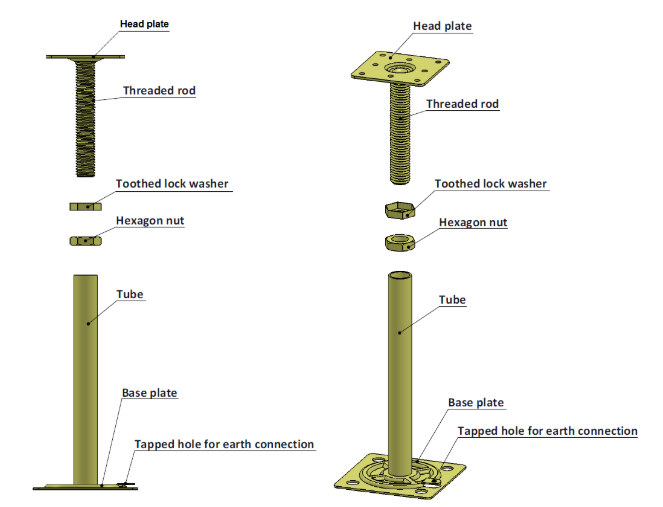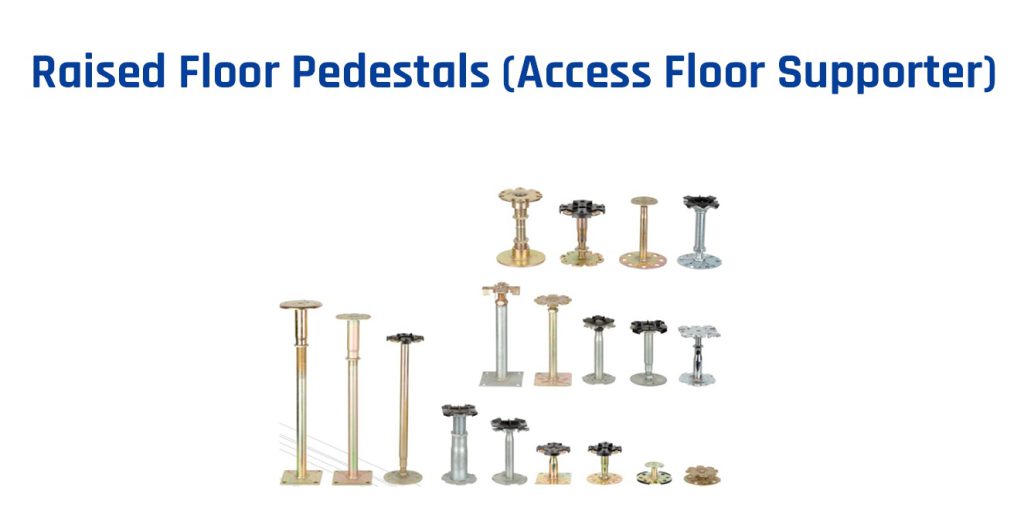Raised floor systems are an integral part of modern office spaces, data centers, and other environments that require underfloor services. A critical component of these systems is the raised floor pedestal, which provides support and stability to the raised floor panels. In this blog, we will talk about the various aspects of raised floor pedestals, helping you understand their types, dimensions, heights, load capacities, and how to select the right one for your needs.
What are Raised Floor Pedestals?
Raised floor pedestals are a fundamental component in the construction of raised flooring systems. These systems create a space between the subfloor and the floor itself, allowing for the organization of wiring, piping, and other necessary infrastructures. The selection of the appropriate raised floor pedestal is crucial for ensuring stability, safety, and the desired height adjustment for the flooring system.

Structure & Dimensions of Raised Floor Pedestal
The structure of a raised floor pedestal, particularly the HuiYa Access Floor Pedestal System, is designed to provide a stable and adjustable foundation for raised floor systems. These pedestals are crucial for maintaining an organized space for various infrastructures like wiring and piping beneath the raised floor. Below is a detailed breakdown of the structure of the raised floor pedestal:

Base Plate
- Size: Available in various sizes, typically 95 mm, 125 mm, and 150 mm.
- Thickness: Usually 2 mm, but can be customized to 3 mm or 4 mm.
- Material: Made of cold-rolled carbon steel, often stamped with ribs for added resistance to twisting and comes with a grounding spur.
- Fixing Method: Includes two holes for securing it to the subfloor using glue or screws.
Pedestal Tube
- Diameter: Customizable; standard diameters are 25 mm, 32 mm, 38 mm, 45 mm, and 50 mm.
- Thickness: The wall thickness can vary from 1.0 mm to 3.0 mm.
- Material: Typically made of carbon steel with anti-rust treatment such as electrolytic galvanization.
Head Plate
- Shape: Available in square and round shapes.
- Size: Square head plates are generally 75 mm x 75 mm, while round head plates are 95 mm x 95 mm.
- Thickness: Commonly 3 mm, but can be produced in 4-5 mm thickness for custom requirements.
- Compatibility: Square head plates are suitable for all-steel anti-static floor series, and round head plates are ideal for calcium sulfate and all-aluminum anti-static floors.
Thread Rod
- Size: Available in sizes such as M18, M22, and M28.
- Adjustability: The all-thread rod is used for height adjustment, allowing for a range typically within +/- 10 mm or more, depending on the pedestal type.
Adjustment Mechanism
- Locking Nut: Utilized to secure the adjusted height of the pedestal.
- Height Adjustment Range: Pedestals can be adjusted to various heights, from 55 mm up to 1500 mm for different applications.
Finish and Color
- Galvanized Type: Offers anti-rust properties with options like white galvanizing and yellow galvanizing.
- Spray Paint Type: An external coating that provides both an aesthetic finish and rust prevention.
Types of Raised Floor Pedestals
There are several different types of raised floor pedestals to cater to various applications, including:
- Standard Pedestals: Typically used in general office spaces, these pedestals consist of a base, a threaded rod, and a head plate.
- Heavy Duty Pedestals: Designed to support heavier loads, these are common in data centers and industrial settings.
- Low Profile Pedestals: Suited for areas where only a small elevation is required.
- Heavy Duty Equipment Supports: These are installed under heavy equipment to provide extra support.
Dimensions of Raised Floor Pedestals
- Raised floor pedestals come in various dimensions to meet the needs of different flooring systems:
- Tube Diameter: Regular diameters include Φ25mm, Φ32mm, Φ38mm, Φ45mm, and Φ50mm.
- Tube Thickness: Standard thicknesses are 1.0mm and 1.2mm, with options up to 3.0mm for customized requirements.
- Head Plate Size: Square head plates typically measure 75mm x 75mm, while round head plates are usually 95mm x 95mm.
- Base Plate Size: Common sizes are 95mm x 95mm, with thicknesses ranging from 2mm to 4mm.
Heights of Raised Floor Pedestals
The height of raised floor pedestals can be customized:
- Standard Heights: These can range from 55mm to 1500mm, depending on the finish height requirement of the project.
- Adjustment Range: Most pedestals allow for an adjusting range within 10mm for fine-tuning.

Load Capacity of Raised Floor Pedestals
Load capacity is a crucial factor when selecting pedestals:
- Standard Pedestals: Can support typical office equipment and furniture loads.
- Heavy Duty Pedestals: Can support loads of 5,000 pounds or more, suitable for heavy equipment.
- Heavy Duty Equipment Supports: Specifically designed to support the heaviest loads directly under equipment.
Choosing Right Raised Floor Pedestal For Your Access Floor System
When selecting a raised access floor pedestal, consider the following factors:
- Load Requirements: Assess the weight of equipment and furniture that the pedestals need to support.
- Height Requirements: Determine the necessary finish height for your space.
- Floor Type: Different floor types (e.g., all-steel, concrete-filled, woodcore, calcium sulphate) may require specific pedestal types.
- Environment: Consider whether the pedestals will be used indoors or outdoors as this affects the material and treatment for corrosion resistance.
- Customization: Determine if you need customized dimensions or load capacities beyond standard offerings.
Raised Access Floor Pedestal Installation and Customization
- Installation: Pedestals should be installed by experienced professionals to ensure stability and safety. Make sure to follow the manufacturer’s guidelines for the correct installation process.
- Customization: Manufacturers like HuiYa offer custom solutions, including different colors, galvanized or spray paint types, and adhesive options for secure installation.
Raised floor pedestals are a vital part of any raised floor system, providing the necessary support and stability for a safe and functional space. When selecting the right pedestal, it’s essential to consider the environment, load requirements, and compatibility with your raised floor panels. With a wide range of options and customizations available, you can find the perfect pedestal solution to match your specific needs.
